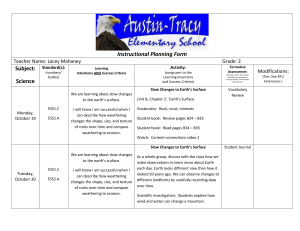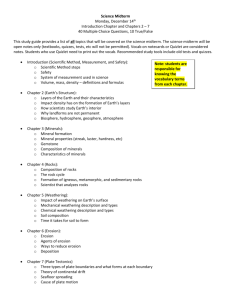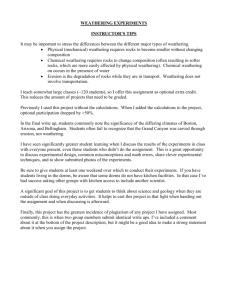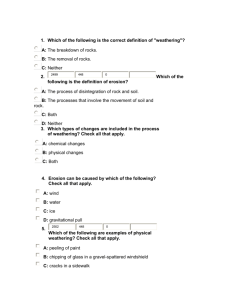Instructional Planning Form
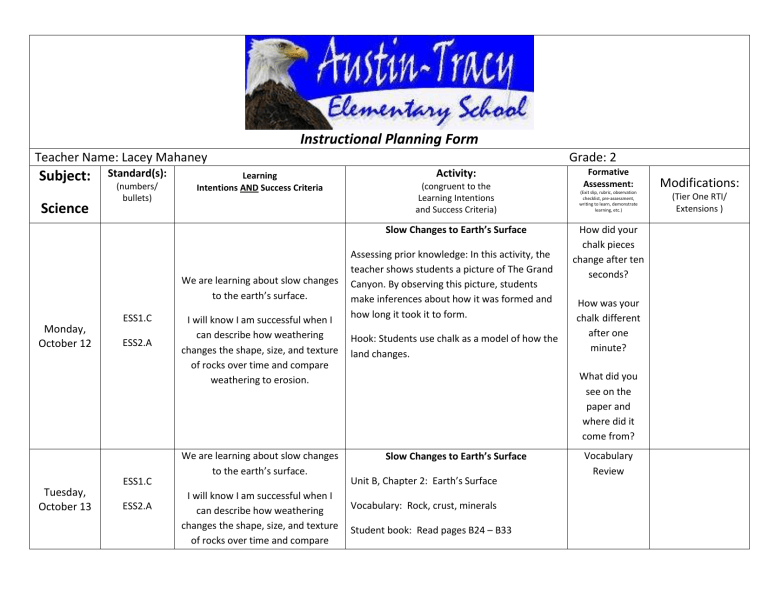
Instructional Planning Form
Teacher Name: Lacey Mahaney Grade: 2
Subject:
Science
Standard(s):
(numbers/ bullets)
Learning
Intentions AND Success Criteria
Activity:
(congruent to the
Learning Intentions and Success Criteria)
Slow Changes to Earth’s Surface
Formative
Assessment:
(Exit slip, rubric, observation checklist, pre-assessment, writing to learn, demonstrate learning, etc.)
How did your
Monday,
October 12
ESS1.C
ESS2.A
We are learning about slow changes to the earth’s surface.
I will know I am successful when I can describe how weathering changes the shape, size, and texture of rocks over time and compare weathering to erosion.
Assessing prior knowledge: In this activity, the teacher shows students a picture of The Grand
Canyon. By observing this picture, students make inferences about how it was formed and how long it took it to form.
Hook: Students use chalk as a model of how the land changes. chalk pieces change after ten seconds?
How was your chalk different after one minute?
What did you see on the paper and where did it come from?
We are learning about slow changes to the earth’s surface.
Slow Changes to Earth’s Surface Vocabulary
Review
ESS1.C Unit B, Chapter 2: Earth’s Surface
Tuesday,
October 13 ESS2.A
I will know I am successful when I can describe how weathering changes the shape, size, and texture of rocks over time and compare
Vocabulary: Rock, crust, minerals
Student book: Read pages B24 – B33
Modifications:
(Tier One RTI/
Extensions )
Wednesday,
October 14
Thursday,
October 15
Friday,
October 16
ESS1.C
ESS2.A
ESS1.C
ESS2.A
ESS1.C
ESS2.A weathering to erosion. Questioning: Ask “for discussion” questions
Slow Changes to Earth’s Surface
We are learning about slow changes to the earth’s surface. Unit B, Chapter 2: Earth’s Surface
I will know I am successful when I can describe how weathering changes the shape, size, and texture of rocks over time and compare weathering to erosion.
Vocabulary: Rock, crust, minerals
Student book: Review pages B24 – B33
Student book: Read pages B34 – B35
Watch: Content connections video 2
Vocabulary
Review
Slow Changes to Earth’s Surface
We are learning about slow changes to the earth’s surface.
I will know I am successful when I can describe how weathering changes the shape, size, and texture of rocks over time and compare weathering to erosion.
As a whole group, discuss with the class how we make observations to learn more about Earth each day. Earth looks different now than how it looked 50 years ago. We can observe changes to different landforms by carefully recording data over time.
Scientific investigation: Students explore how wind and water can change a mountain.
Student Journal
Slow Changes to Earth’s Surface
We are learning about slow changes to the earth’s surface.
I will know I am successful when I can describe how weathering changes the shape, size, and texture of rocks over time and compare weathering to erosion.
As a whole group, discuss with the class how we make observations to learn more about Earth each day. Earth looks different now than how it looked 50 years ago. We can observe changes to different landforms by carefully recording data over time.
Scientific investigation: Students explore how wind and water can change a mountain.
Student Journal
